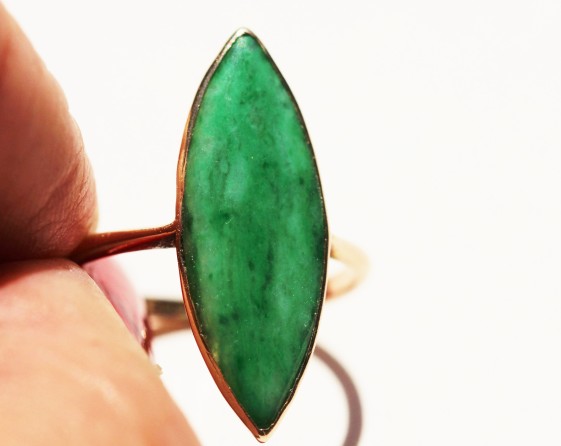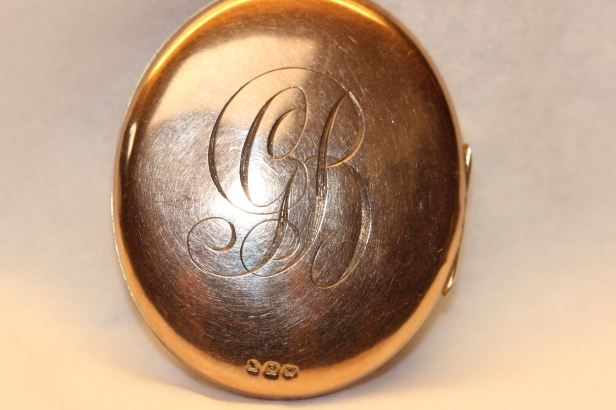With the discovery of gold in the state of Victoria in the 1850s, Melbourne became the centre of jewellery manufacture. Whilst some jewellers focussed on the design of jewellery using Australian flora and fauna, usually a kangaroo and/or emu, many continued to copy existing British designs. Goldfield brooches, comprising crossed picks and shovels, or little buckets and other tools, also with gold nuggets, were produced in the Victorian goldfields in the 1850s, then later in NSW and Western Australia. Such brooches also spread to South Africa in the 1890s and to the American Klondike gold rush in the late 1890s.
Other gold jewellery took the form of brooches and bracelets set with leaves, vines and tendrils, or with scrolled and ribboned borders. Ornate pieces had tassels. Australian gems such as opals, pearls and sapphires were showcases, together with an enormous numbers of other gems found in Australia, such as malachite, agate, quartz, and chrysophase.
Patriotic jewellery became popular after the Federation of Australia in 1901, depicting the Australian continent, kangaroos, emus, kookaburras, flags, boomerangs or gumleaves, and again during and after the WWI. It was often inexpensive.
Examples of Australian antique jewellery:
Antique 15ct seed pearl starburst pendant/brooch – by Duggin, Shappere & Co.

Duggin, Shappere & Co was founded in Melbourne in 1896 and closed in 1932. They used seed pearls a lot in their original designs. Their mark was an ‘Anchor’.
1870s Brooch – by Lamborn and Wagner

Lamborn and Wagner was founded in Melbourne in 1858 and closed in 1885. They were one of the earliest manufacturing jewellers in Australia. They produced gold jewellery with a botanical theme, with ornate borders of grapes and vine lines, sometimes incorporating kangaroos and emus. Their mark was the ‘L&W’ mark, sometimes accompanied by two ‘Crowns’ or by two ‘Five-pointed stars’.
Antique Jade Ring, 18ct – by T Gaunt

T Gaunt and Co was founded by Thomas Gaunt in 1852. In 1892, it was acquired by F W Heath and continued as jewellers until 1979. Its marks were ‘Gaunt’ or ‘T Gaunt’.
Antique gold locket– Willis and Sons

R & T Willis started a jewellery partnership in 1858 in Melbourne. The family remained involved in the business for many decades. In 1904, it was incorporated as Willis and Sons Pty Ltd and was a major jewellery manufacturer for the next two decades. It then traded primarily as a wholesale jeweller. Their mark was a ‘Unicorn head’.


I just came across a Willis pendant that I wanted to double check that it was his. And who maybe it was meant for as a ‘m’ is engraved in the cross
LikeLike
Hi, Willis used two sets of marks. It could be a Unicorn head, 9, W or it could be the Australian hallmarks, with a unicorn head, quality mark in carats, and the device (wheat sheaf, hanged sheep or ship).
Margaret
LikeLike
Can you give me any information about the bangle shown above
LikeLike
Hi Trevor,
I haven’t got the bangle anymore but it was inscribed ‘Presented by GJ to IN, 12 September 1884’. The centre of the piece had a bunch of grapes hanging from a vines surrounded by grapes leaves and tendrils. Very ornate, Margaret
LikeLike
Thank You Margaret,
I have just found the ‘Sister’ bangle only mine has ferns across the top instead of grape leaves. I am keen to identify the maker who I suspect was in Melbourne.
The date inscribed on yours if helpful.
Thank you for your really interesting articles.
Regards
Trevor Hancock
LikeLike
I have read this web information attentively then I got lots of valuable information from here. I will share this website with my friends I hope they will be happy for this information.
LikeLike
Thanks Zion
LikeLiked by 1 person